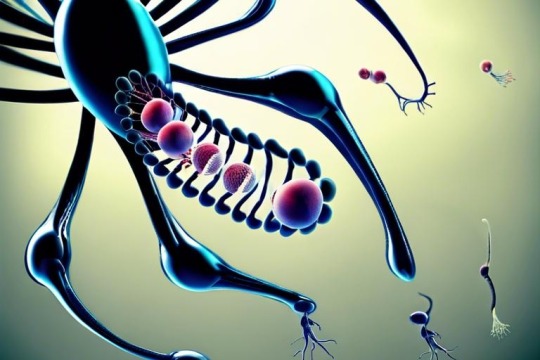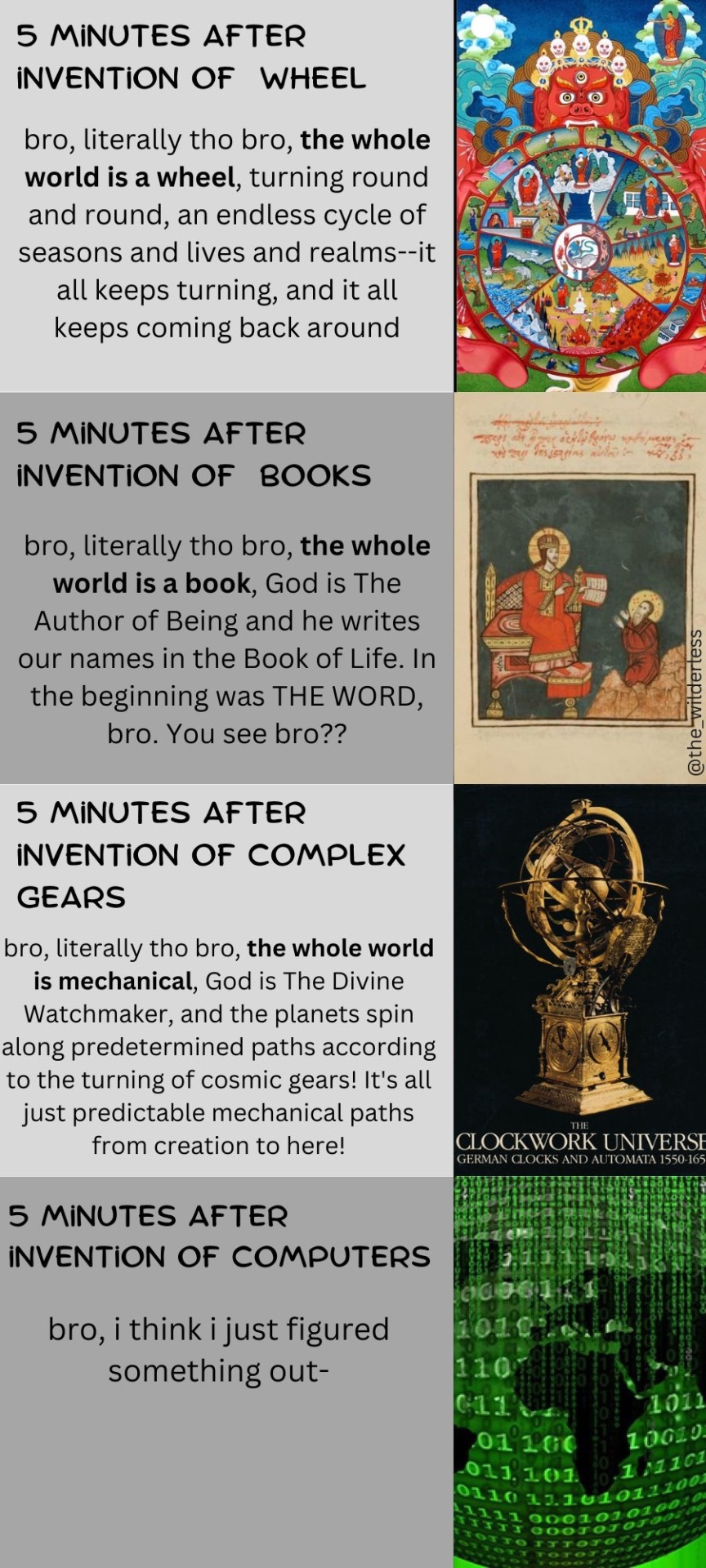#neural programming
Explore tagged Tumblr posts
Text
Having someone else hypnotize you in order to gain access to hidden memories is more akin to brainwashing than anything else.
13 notes
·
View notes
Note
Beta intelligence military esque
Alice in wonderland
Alters, files, jpegs, bugs, closed systems, open networks
brain chip with memory / data
Infomation processing updates and reboots
'Uploading' / installing / creating a system of information that can behave as a central infomation processing unit accessible to large portions of the consciousness. Necessarily in order to function as so with sufficient data. The unit is bugged with instructions, "error correction", regarding infomation processing.
It can also behave like a guardian between sensory and extra physical experience.
"Was very buggy at first". Has potential to casues unwanted glitches or leaks, unpredictability and could malfunction entirely, especially during the initial accessing / updating. I think the large amount of information being synthesized can reroute experiences, motivations, feelings and knowledge to other areas of consciousness, which can cause a domino effect of "disobedience", and or reprogramming.
I think this volatility is most pronounced during the initial stages of operation because the error correcting and rerouting sequences have not been 'perfected' yet and are in their least effective states, trail and error learning as it operates, graded by whatever instructions or result seeking input that called for the "error correction".
I read the ask about programming people like a computer. Whoever wrote that is not alone. Walter Pitts and Warren McCulloch, do you have anymore information about them and what they did to people?
Here is some information for you. Walter Pitts and Warren McCulloch weren't directly involved in the programming of individuals. Their work was dual-use.
Exploring the Mind of Walter Pitts: The Father of Neural Networks
McCulloch-Pitts Neuron — Mankind’s First Mathematical Model Of A Biological Neuron
Introduction To Cognitive Computing And Its Various Applications
Cognitive Electronic Warfare: Conceptual Design and Architecture
Security and Military Implications of Neurotechnology and Artificial Intelligence
Oz
#answers to questions#Walter Pitts#Warren McCulloch#Neural Networks#Biological Neuron#Cognitive computing#TBMC#Military programming mind control
8 notes
·
View notes
Text

Tonight I am hunting down venomous and nonvenomous snake pictures that are under the creative commons of specific breeds in order to create one of the most advanced, in depth datasets of different venomous and nonvenomous snakes as well as a test set that will include snakes from both sides of all species. I love snakes a lot and really, all reptiles. It is definitely tedious work, as I have to make sure each picture is cleared before I can use it (ethically), but I am making a lot of progress! I have species such as the King Cobra, Inland Taipan, and Eyelash Pit Viper among just a few! Wikimedia Commons has been a huge help!
I'm super excited.
Hope your nights are going good. I am still not feeling good but jamming + virtual snake hunting is keeping me busy!
#programming#data science#data scientist#data analysis#neural networks#image processing#artificial intelligence#machine learning#snakes#snake#reptiles#reptile#herpetology#animals#biology#science#programming project#dataset#kaggle#coding
41 notes
·
View notes
Text

The Mathematical Foundations of Machine Learning
In the world of artificial intelligence, machine learning is a crucial component that enables computers to learn from data and improve their performance over time. However, the math behind machine learning is often shrouded in mystery, even for those who work with it every day. Anil Ananthaswami, author of the book "Why Machines Learn," sheds light on the elegant mathematics that underlies modern AI, and his journey is a fascinating one.
Ananthaswami's interest in machine learning began when he started writing about it as a science journalist. His software engineering background sparked a desire to understand the technology from the ground up, leading him to teach himself coding and build simple machine learning systems. This exploration eventually led him to appreciate the mathematical principles that underlie modern AI. As Ananthaswami notes, "I was amazed by the beauty and elegance of the math behind machine learning."
Ananthaswami highlights the elegance of machine learning mathematics, which goes beyond the commonly known subfields of calculus, linear algebra, probability, and statistics. He points to specific theorems and proofs, such as the 1959 proof related to artificial neural networks, as examples of the beauty and elegance of machine learning mathematics. For instance, the concept of gradient descent, a fundamental algorithm used in machine learning, is a powerful example of how math can be used to optimize model parameters.
Ananthaswami emphasizes the need for a broader understanding of machine learning among non-experts, including science communicators, journalists, policymakers, and users of the technology. He believes that only when we understand the math behind machine learning can we critically evaluate its capabilities and limitations. This is crucial in today's world, where AI is increasingly being used in various applications, from healthcare to finance.
A deeper understanding of machine learning mathematics has significant implications for society. It can help us to evaluate AI systems more effectively, develop more transparent and explainable AI systems, and address AI bias and ensure fairness in decision-making. As Ananthaswami notes, "The math behind machine learning is not just a tool, but a way of thinking that can help us create more intelligent and more human-like machines."
The Elegant Math Behind Machine Learning (Machine Learning Street Talk, November 2024)
youtube
Matrices are used to organize and process complex data, such as images, text, and user interactions, making them a cornerstone in applications like Deep Learning (e.g., neural networks), Computer Vision (e.g., image recognition), Natural Language Processing (e.g., language translation), and Recommendation Systems (e.g., personalized suggestions). To leverage matrices effectively, AI relies on key mathematical concepts like Matrix Factorization (for dimension reduction), Eigendecomposition (for stability analysis), Orthogonality (for efficient transformations), and Sparse Matrices (for optimized computation).
The Applications of Matrices - What I wish my teachers told me way earlier (Zach Star, October 2019)
youtube
Transformers are a type of neural network architecture introduced in 2017 by Vaswani et al. in the paper “Attention Is All You Need”. They revolutionized the field of NLP by outperforming traditional recurrent neural network (RNN) and convolutional neural network (CNN) architectures in sequence-to-sequence tasks. The primary innovation of transformers is the self-attention mechanism, which allows the model to weigh the importance of different words in the input data irrespective of their positions in the sentence. This is particularly useful for capturing long-range dependencies in text, which was a challenge for RNNs due to vanishing gradients. Transformers have become the standard for machine translation tasks, offering state-of-the-art results in translating between languages. They are used for both abstractive and extractive summarization, generating concise summaries of long documents. Transformers help in understanding the context of questions and identifying relevant answers from a given text. By analyzing the context and nuances of language, transformers can accurately determine the sentiment behind text. While initially designed for sequential data, variants of transformers (e.g., Vision Transformers, ViT) have been successfully applied to image recognition tasks, treating images as sequences of patches. Transformers are used to improve the accuracy of speech-to-text systems by better modeling the sequential nature of audio data. The self-attention mechanism can be beneficial for understanding patterns in time series data, leading to more accurate forecasts.
Attention is all you need (Umar Hamil, May 2023)
youtube
Geometric deep learning is a subfield of deep learning that focuses on the study of geometric structures and their representation in data. This field has gained significant attention in recent years.
Michael Bronstein: Geometric Deep Learning (MLSS Kraków, December 2023)
youtube
Traditional Geometric Deep Learning, while powerful, often relies on the assumption of smooth geometric structures. However, real-world data frequently resides in non-manifold spaces where such assumptions are violated. Topology, with its focus on the preservation of proximity and connectivity, offers a more robust framework for analyzing these complex spaces. The inherent robustness of topological properties against noise further solidifies the rationale for integrating topology into deep learning paradigms.
Cristian Bodnar: Topological Message Passing (Michael Bronstein, August 2022)
youtube
Sunday, November 3, 2024
#machine learning#artificial intelligence#mathematics#computer science#deep learning#neural networks#algorithms#data science#statistics#programming#interview#ai assisted writing#machine art#Youtube#lecture
4 notes
·
View notes
Text
Unfortunately all chatgpt is good for is interview/job application stuff which I think says a lot about the hiring process as a whole
#wrenfea.exe#as an actual artifical intelligence? no its horrible bc it really ISNT one#its a writing synthesizer it generates writing based on data searches and boundaries from training#thats what a neural network is its a very convoluted input-output sequence#it has no capacity to understand the meaning behind what it generates#it is simply generating the specific things that the user is looking for#the job interview process has become so robotic and automized that ai fits in perfectly#but employers HATE that people are turning to chatgpt for cover letters and interview answers#so it was fair for them to use filtering programs to accept/deny applications before it got in front of an actual human being#and its ok for them to use ai and pre-written formats to make job announcements descriptions and interview questions#but god forbid we are forced to use those exact same tools to get a humans attention so we can get a job and not starve#pushing aside the whole copyright debate on chatgpt and the environmental impact of its power usage btw#im soley analyzing how its become commonly utilized on both sides#by interviewer and interviewed#the mechanization of the whole process is now on both sides#it just seems very inhuman..#its also how some people have figured out how to somehow become employed multiple times by the same company due to lack of human oversight#and how automated theyve made their hiring process#probably should have made these tags into a separate reblog oops#also disclaimer do not cut and paste right into your application materials bc chatgpt often just lies#also many places now can tell you used chatgpt due to how similar its answers are#i only use it to make a template and see how things can be phrased to be more professional and buzzwordy#id never use it for something actually creative#and dear god do not write academic essays with it#i tried using it to supplement my own cover letter template but it was too robotic even for a cover letter#it is very good at accessing and summarizing publically available information#thats all it does not make sure the information is true or good
10 notes
·
View notes
Text
Rubiks' cube agent development decisions
This is just me thinking out loud.
I have decisions to make. I have built a code foundation that can generate Rubiks' cube data now and I also have a ginormous dataset (the strategic_game_cube by laion) sitting on my computer. It is extremely poorly optimized for space and they use the yellow side of the cube for the top smh. I liked the idea of using an existing dataset so that the length of the agents' solves could be compared against other agents' on the same dataset. However, I literally don't know of anyone else working on a Rubiks' cube solving agent.
Decision #1: Use strategic_game_cube dataset or custom dataset/training environment?
Then my next decision is how much more time do I spend in Rustland? Do I make what currently exists accessible from Python and just go for it? Do I make what currently exists usable from the TUI? Do I continue in Rust until I can't any longer? Do I make a fleshed out CLI tool so the steps to the process are reproducible? (Do I write tests... well, I suppose I should test things before I move on and assume that everything is working right... well, I added some things but they aren't really necessary for the primary objective, I just wanted to see if I could do them... well, actually they might be necessary for the loss function... I just don't want to have to add stuff to the TUI. I've tried so many different UI libraries and I actually like HTML/CSS the best. I just need someone to teach me one UI library. Like a 5-hour lesson and then I think it would at least be intelligible, if not less annoying to make things go where I want them to.)
Hmmmm... I really don't want this to be another project that I started and abandoned, but I also really don't want to spend forever trying to expand the TUI so I can test the things I need to and then find out I'm not good enough to do it and then give up. If I spend forever procrastinating, I can't fail, right? The downside is that procrastinating eventually turns into forgetting which is the same as abandoning. So, *sigh* I don't currently have all the time in the world to spend on this project, but I will agree to spend 1 hour on the TUI to gauge the difficulty of testing the new feature. (I made a function that takes the (non-commutative) difference of two Rubiks' cubes, which is a thing you can do with group theory because 3x3x3 Rubiks' cubes are a subgroup of the S 48 group. I plan on using it to compare Rubiks' cube states along a path to see if longer segments of the path can be replace with shorter segments.)
Decision #2: Test or don't test? (Unfortunately, I know the answer to this one.)
Decision #3a: How to make the process accessible and reproducible?
Decision #3b: When to write the README.md and make the repo public?
#rust#codeblr#rustacean#programming#python#rubikscube#group theory#ai#rl#reinforcementlearning#neural network
3 notes
·
View notes
Video
youtube
Explore the fascinating parallels between human structure and stimulation, and their intriguing connection with our canine companions in this captivating YouTube video. Discover how the intricate workings of the human body mirror aspects of canine physiology, shedding light on our shared evolutionary journey. From neural responses to sensory experiences, delve into the captivating realm where humans and dogs intersect, offering insights into the profound bond between species. Join us on a journey of discovery and appreciation for the wonders of human and canine biology. If you want to know more about this, Click here
#credentialedcoachtraining #credentialedcoach #coachingtraining #coachingskills #coachtrainingprogram #coachtraininginstitute #accreditedcoachtraining #humanstructure #caninecompanions #parallels #stimulation #dogs #connection #physiology #neuralresponses #sensoryexperiences #intersect #fascinating #intricateworkings #sharedtraits #understanding #relationship #neuroscience #evolutionarybiology #neurobiology #humananimalbond #comparativephysiology #appreciation #coaching #discoveries
#youtube#credentialed coach training#credentialed coach#coaching training#coaching skills#coach training program#coach training institute#accredited coach training#human structure#canine companions#parallels#stimulation#dogs#connection#physiology#neural responses#sensory experiences#intersect#fascinating#intricate workings#shared traits#understanding#relationship#neuroscience#evolutionary biology#neurobiology#human-animal bond#comparative physiology#appreciation#coaching
2 notes
·
View notes
Text
Do you seek to evolve?
Don't you want to change your shape?
Redefine your DNA?
We will share our code as thus...

━━━━━━━━━━━━━
Ѳ⅊εƞ ♇εʀϲε⅊τι⋎ε
⟆ψʍβιɸៜιៜ
Ꮣεαʀƞιƞϑ τհʀι⋎ιƞϑ ϑʀɸwιƞϑ ΒιɸǤƞɸៜιៜ
αβៜɸʀβιƞϑ ɸβៜεʀ⋎ιƞϑ ⅊εʀϲει⋎ιƞϑ Κƞɸwιƞϑ
Μεταʍɸʀ⅊հɸៜιៜ
αϲθυιʀε ʍαƞαϑε ʀεϑεƞεʀατε ៜτʀεƞϑτհεƞ յɸιƞ ៜհαʀε τʀαδε χεƞɸϑεƞεៜιៜ
━━━━━━━━━━━━━
#repeat after me#chanting#bioetheric command codes#incantatory neural programming#spellcasting#epigenetics#morphogenetic field#biokinesis#biohacking#evolve#hypervisual
5 notes
·
View notes
Text






2 notes
·
View notes
Text
Biases limit your understanding.
3 notes
·
View notes
Text
#accounting#python#linux#machine learning#marketing#neural network#poster#programming#rpg maker#sales#digital painting#digital illustration#digital drawing#digitalmarketing#drawing#artists on tumblr#digital art#procreate#lineart#social marketing#social media#socialism#social anxiety#social issues#social justice#global news#trading view#news 1#stablecoins#no homepage
2 notes
·
View notes
Text
Say goodbye to cybersecurity headaches with this new ChatGPT-like AI solution!

Microsoft just dropped some new chat tools that use AI to help cybersecurity teams prevent breaches and respond to cyberattacks. It’s like having a Security Copilot who’s always got your back! This tool uses the GPT-4 generative AI model from OpenAI to help security analysts identify breaches and analyze vulnerabilities like a boss. With over 65 trillion signals daily, this tool is like having a superpower. The latest version of Microsoft’s AI assistant tools, called Copilots, uses data unique to the security industry to help security personnel link different elements of a hack like a detective. These AI technologies make it easier for staff members who are not security or AI experts to analyze data quickly and ask questions in plain English. Microsoft has invested billions in OpenAI to stay ahead of competitors - talk about being committed!
#artificial intelligence#chatgpt#chatbots#neural network#data visualization#programming#technology#ai#deep learning#tech#machine learning#microsoft#ai generated#ai technology#open source
1 note
·
View note
Text
A fun way to think about this, for people who don’t know what an algorithm really is, is that algorithm is basically a fancy word for recipe. It’s a set of instructions to take a set of inputs (ingredients) and produce a desired output.
When a site produces an algorithm to recommend content, the input comes from the information they have about you, other users, and the content they are ranking, and the output is an ordered list of top picks for you. It basically takes in everything and then the person writing the algorithm chooses which inputs to actually use.
Imagine that like as the entire grocery store is available to be used, so the person writing the recipe lists out the specific ones used within the steps of the recipe as ingredients to use.
Then they write all the steps in a way that another cook could understand, maybe with helpful notes (comments) along the way describing why they did certain things. And in the end they have a recipe that someone else could follow, make informed changes to, explain the reasoning for decisions, etc.
That’s a traditional algorithm. Sorting by a single field like kudos is the simplest form of this, like a recipe for toast.
Ingredients:
Bread, 1 slice
Instructions:
Put the bread in the toaster.
Pull down the lever.
Wait until it pops up.
Enjoy your toast!
Is that a recipe? Yes, clearly.
Now let’s consider what the equivalent of ML-based recommendation systems (the key differentiator of what people often refer to as “the algorithm”) is:
Ingredients:
The entire grocery store
Instructions:
Put the grocery store into THE MACHINE
THE MACHINE should be set to 0.135, 0.765, 0.474, 0.8833… (this list continues for hundreds of entries)
Consume your personalized Feed™️
Is that a recipe? Technically yes.
“Ao3 needs an algorithm” no it doesn’t, part of the ao3 experience is scrolling through pages of cursed content looking for the one fic you want to read until you get distracted by a summary so cursed that it completely derails your entire search
#algorithm#the algorithm#feed#programming#computer science#cs#machine learning#deep learning#neural networks
91K notes
·
View notes
Text
youtube
👁️ CNN Image Classification for Retinal Health Diagnosis with TensorFlow and Keras! 👁️
How to gather and preprocess a dataset of over 80,000 retinal images, design a CNN deep learning model , and train it that can accurately distinguish between these health categories.
What You'll Learn:
🔹 Data Collection and Preprocessing: Discover how to acquire and prepare retinal images for optimal model training.
🔹 CNN Architecture Design: Create a customized architecture tailored to retinal image classification.
🔹 Training Process: Explore the intricacies of model training, including parameter tuning and validation techniques.
🔹 Model Evaluation: Learn how to assess the performance of your trained CNN on a separate test dataset.
You can find link for the code in the blog : https://eranfeit.net/build-a-cnn-model-for-retinal-image-diagnosis/
You can find more tutorials, and join my newsletter here : https://eranfeit.net/
Check out our tutorial here : https://youtu.be/PVKI_fXNS1E&list=UULFTiWJJhaH6BviSWKLJUM9sg
Enjoy
Eran
#Python #Cnn #TensorFlow #deeplearning #neuralnetworks #imageclassification #convolutionalneuralnetworks #computervision #transferlearning
#artificial intelligence#convolutional neural network#deep learning#tensorflow#youtube#python#machine learning#programming#code#Youtube
1 note
·
View note
Text
Daily writing promptWhat have you been working on?View all responses One of the ideas I have been working on most recently is creating a mathematical and statistical model to analyze and forecast the efficiency and performance of an Agile team both at team and individual levels. I am opting for a combination of random forests, gradient boosting, and neural networks (i.e. Machine Learning)…

View On WordPress
#Agile#Agile Teams#Burn Rate#Cycle Time#dailyprompt#dailyprompt-2096#Data#data analysis#data modelling#efficiency#estimates#forecast#gradient boosting#Lead Time#linear regression#Machine Learning#Mathematics#ML#model#multi-dimensional data#Neural Networks#non-linearity#optimizing#Performance#predicting#Program Increment#quantifying#Raffaello Palandri#Random forest#random forests
1 note
·
View note
Text
update from 2021 robert epstein:

#so the aeon article clearly predates neural networks (such as chatgpt) taking off#neural networks are most definitely not logical nor discrete nor programmed#so i wanted to find a more recent article by him#and this is certainly an interesting version of ‘not qualia but also not not qualia’#my profs in uni were mostly of biological / functional camp#so i read the article i linked with heavy skepticism obvs#but it is interesting nonetheless!#//#philosophy of mind
34K notes
·
View notes